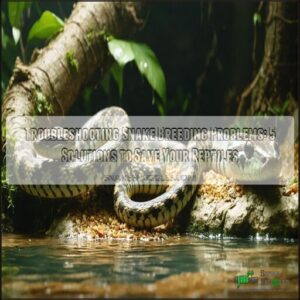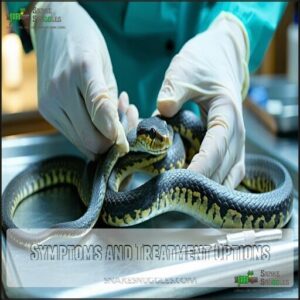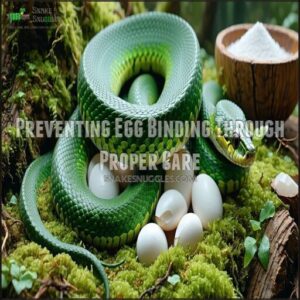This site is supported by our readers. We may earn a commission, at no cost to you, if you purchase through links.
 When you’re troubleshooting snake breeding problems, start by checking your temperature cycling and humidity levels—these are often the culprits behind reluctant reptiles.
When you’re troubleshooting snake breeding problems, start by checking your temperature cycling and humidity levels—these are often the culprits behind reluctant reptiles.
You’ll need to verify that your snakes are sexually mature and properly conditioned through brumation if required for their species.
Examine your pairing strategy; some snakes simply aren’t compatible or may be stressed by their enclosure setup.
Health issues like obesity, parasites, or nutritional deficiencies can also prevent successful breeding.
Monitor feeding patterns and make certain proper weight before attempting breeding.
The difference between breeding failure and success often lies in small environmental adjustments that mimic natural conditions perfectly.
Table Of Contents
Key Takeaways
- You’ll need to monitor environmental conditions carefully, as proper temperature cycling, humidity levels, and lighting that mimics seasonal changes are often the root causes of snake breeding failures.
- Your snakes’ health is critical for successful breeding—watch for issues like anorexia, obesity, parasites, or nutritional deficiencies that can prevent reproduction.
- You can prevent dangerous complications like egg binding by ensuring proper calcium supplementation, adequate hydration, and suitable nesting sites for your female snakes.
- You should maintain genetic diversity in your breeding program to produce healthier offspring and avoid harmful mutations that can result from excessive line breeding.
Snake Breeding Challenges
You’ll face numerous obstacles when breeding snakes, including environmental mismatches, stress factors, incompatible pairings, and potential genetic issues that can prevent successful reproduction.
Recognizing snake breeding challenges early ensures targeted solutions for stress, genetics, and environment, paving the way for successful reproduction.
Recognizing these challenges early allows you to implement targeted solutions like temperature adjustments, stress reduction techniques, or genetic testing to substantially improve your breeding success rates, which can help mitigate stress factors.
Environmental Factors Affecting Breeding
In successful snake breeding, temperature gradients play a vital role.
You’ll need to maintain proper humidity levels (60-80% for most species) and establish consistent lighting cycles that mimic seasonal changes.
Your enclosure size must accommodate both snakes comfortably during breeding.
Snake breeding problems often stem from environmental factors like incorrect temperatures (88-92°F for ball pythons during breeding season).
Optimal results require understanding breeding temperature products.
Monitoring these conditions carefully will substantially improve your breeding success rates.
Incompatible Pairings and Stress
Stress-filled encounters between snake pairs can derail your breeding efforts completely.
When you notice refusal to breed or aggressive behaviors, pairing compatibility issues are likely to blame.
Try introducing pairs gradually, allowing them to acclimate to each other’s scents first.
Behavioral monitoring helps identify stress triggers, while environmental enrichment provides security.
Successful snake breeding problems often resolve with strategic stress reduction techniques and patience – rushing snake mating rarely works, emphasizing the need for careful planning and environmental enrichment.
Genetic Issues and Infertility
Beyond stress and incompatible matches, your breeding program can face genetic hurdles.
Infertility causes range from age to inherited health issues that may not be visible.
Consider genetic screening before pairing snakes to identify potential risks.
Many breeding ethics experts recommend tracking trait inheritance carefully—what looks beautiful might carry hidden problems.
Improving snake fertility often means introducing diversity.
Don’t repeatedly breed closely related animals; this weakens genetic health and reduces clutch viability over time.
Understanding snake genetics basics is essential for responsible breeding.
Breeding Health Issues
You’ll need to monitor your breeding snakes for health issues like anorexia, infections, and reproductive complications that can derail your breeding program.
These conditions often manifest during breeding seasons when your reptiles experience increased physiological stress, potentially leading to egg binding, weight loss, or failed clutches.
Anorexia and Refusal to Eat
When breeding snakes, your success hinges on their physical health.
Anorexia and feeding refusal often signal serious issues in breeding specimens.
Your snake’s refusal to eat may result from environmental factors (improper temperature, lighting), breeding-related stress, or underlying diseases requiring veterinary examination.
Monitor snake nutrition carefully during breeding cycles, as weight loss can indicate health problems.
Addressing snake anorexia promptly is critical—healthy eaters make successful breeders, and this is crucial for the snake’s overall physical health, as well as its ability to thrive and become a successful breeder.
Salmonella and Hygiene Practices
While food refusal often signals health issues, Salmonella presents a silent danger in your breeding operation.
Did you know 92.2% of snakes carry Salmonella without showing symptoms? This bacteria can spread to humans through contact with your snakes, their habitats, or contaminated equipment.
Always wash hands thoroughly after handling, disinfect enclosures regularly with bleach solutions, and keep breeding equipment separate from household items to prevent cross-contamination and protect both you and your snake breeding colony.
Regular cleaning prevents parasitic and fungal infections and is crucial for maintaining a healthy environment.
External and Internal Lumps or Swellings
During snake breeding, lumps and swellings can signal serious health concerns.
You’ll need to distinguish between external abscesses, parasitic lumps, and internal issues like organ enlargement or impaction causes.
These problems often contribute to snake reproduction failure.
Veterinary diagnosis through X-rays, blood tests, or aspirate analysis is essential for determining whether you’re dealing with a benign condition or something requiring immediate medical intervention.
Addressing these reptile breeding challenges promptly can prevent further complications.
Egg Binding Complications
You’ll recognize egg binding in your snake when she can’t pass her eggs, creating a life-threatening emergency that requires immediate veterinary intervention.
Proper husbandry prevents this dangerous condition, as consistent temperature, appropriate humidity levels, and adequate nutrition substantially reduce the risk of dystocia in your breeding females.
Causes of Egg Binding and Dystocia
While breeding health issues can impact your snake’s wellbeing, egg binding presents a potentially fatal complication. Understanding what causes egg binding and dystocia can save your reptile’s life.
Five primary causes of egg binding in snakes include:
- Nutritional deficiencies, especially calcium imbalances
- Dehydration impact on egg development and passage
- Physical obstructions in the reproductive tract
- Improper temperatures affecting muscle contractions
- Husbandry factors such as inadequate nesting sites
Snake reproduction failure often stems from these preventable conditions.
Symptoms and Treatment Options
Now that you understand what causes egg binding, you need to recognize the symptoms quickly. Watch for lethargy, breathing difficulties, and visible distress in your female snake.
You’ll notice swelling in her lower body – a telltale sign of trouble.
Treatment options include veterinary intervention for surgical egg removal or manual extraction from the cloaca. During treatment, your snake will need supportive care including hydration and pain management.
Adequate snake pain relief is essential during this period. During treatment, your snake will need hydration and pain management.
Preventing Egg Binding Through Proper Care
Prevention is the cornerstone of successful snake breeding.
You can avoid egg binding through these essential care practices:
- Maintain proper hydration levels with clean water sources and suitable humidity
- Provide regular calcium supplementation to support egg development
- Create appropriate nesting sites with suitable substrates
- Meet adequate exercise needs with proper enclosure space
- Follow a thorough husbandry checklist addressing temperature, lighting, and handling
These snake breeding tips substantially reduce egg-laying difficulties and breeding challenges, making proper hydration and regular calcium supplementation crucial for a successful breeding process, which is the key to avoiding complications, and ensuring the health and well-being of the snakes through successful breeding.
Genetic Abnormalities Risks
You’ll face significant challenges when breeding snakes with undesirable genetic traits, as these can manifest in offspring with compromised health, deformities, or reduced viability.
Understanding inheritance patterns and carefully selecting breeding pairs will help you maintain genetic diversity and produce healthier offspring.
Preventing costly losses and heartbreak in your breeding program is crucial, and this can be achieved by understanding the importance of genetic diversity and carefully managing your breeding pairs to produce healthier offspring.
Identifying Genetic Traits and Morphs
While egg binding complications threaten immediate health, genetic issues present long-term risks.
Accurate morph identification forms the foundation of responsible breeding.
Using genetic testing, you’ll discover which recessive genes and polygenic traits your snakes carry.
MorphMarket’s Traits Indexes help identify color variations through photo databases, while DNA barcoding technology confirms genetic inheritance patterns.
Understanding these markers helps prevent genetic health issues in offspring and reduces the risk of producing snakes with harmful mutations.
Ensuring the health and genetic integrity of snakes is crucial for responsible breeding practices, and utilizing tools like DNA barcoding technology can significantly aid in this endeavor.
Responsible Breeding Practices
Three key ethical considerations must guide your snake breeding program: genetic screening to prevent hereditary defects, maintaining high welfare standards for all animals, and preventing overbreeding through responsible sales practices.
You’ll need to educate yourself continuously about reptile breeding ethics to guarantee each snake produced has a waiting home.
This approach protects your animals but also strengthens the reputation of the breeding community as responsible stewards of reptile breeding ethics, ensuring high standards and preventing overbreeding.
Promoting Genetic Diversity and Health
Now that you’ve established responsible practices, your breeding program needs genetic diversity to thrive.
Avoid genetic bottlenecks by introducing fresh bloodlines through outcrossing. Line breeding might create striking morphs, but it increases genetic risks.
Regular health screening helps identify carriers of problematic traits before breeding. When selecting breeding stock, balance trait selection with overall health markers.
Remember, genetic diversity isn’t just about prettier snakes—it creates hardier offspring that resist disease and live longer. To further support their health, consider supplementing with vitamin D3 for ideal bone health.
Breeding Problem Solutions
You’ll find practical solutions to common breeding obstacles by adjusting environmental parameters, implementing stress reduction techniques, and seeking timely veterinary intervention when necessary.
When your snakes aren’t cooperating, systematic troubleshooting that addresses temperature, humidity, hiding spaces, and compatible pairings can transform your breeding program’s success rate by implementing these changes to create a more favorable environment, which is crucial for breeding program.
Monitoring Behavior and Adjusting Conditions
While addressing genetic concerns is important, your success in snake breeding largely depends on your ability to read Behavioral Cues and make Environmental Tweaks accordingly.
Watching your snakes closely reveals valuable insights about their breeding readiness.
- Monitor Feeding Responses – refusal may indicate breeding season
- Track Shedding Patterns – pre-breeding sheds often look different
- Note Activity Levels – increased movement suggests breeding interest
- Document temperature preferences – snakes will seek ideal breeding temps
- Record weight fluctuations – especially important for females
Stress Reduction Techniques and Hiding Spots
Four essential stress reduction techniques can dramatically improve your snake breeding success.
Provide secure hides at both warm and cool ends of the enclosure enrichment setup, creating visual barriers that allow your reptiles to retreat when feeling threatened.
Minimize handling during breeding season and maintain proper temperature gradients to reduce snake stress.
Remember, a relaxed snake breeds more readily—place hiding places strategically throughout the snake enclosure to create a secure environment that mimics their natural habitat.
Adding appropriate reptile hide options can greatly improve breeding success.
Veterinary Care and Intervention When Necessary
While hiding spots help reduce stress, some breeding issues require professional help. When your snake shows abnormal behavior, seek veterinary assistance immediately.
Reptile-experienced vets can perform diagnostic procedures like X-rays and blood tests to identify problems. Egg binding often necessitates surgical options, followed by proper post-op care.
Regular health checkups prevent breeding diseases from becoming life-threatening. Maintaining proper snake enclosure hygiene is also essential for preventing common ailments.
Remember, timely emergency intervention is your breeding program’s safety net – don’t wait until it’s too late, as this can lead to life-threatening consequences, and always prioritize proper post-op care for the best outcomes.
Frequently Asked Questions (FAQs)
When you see one snake, are there more?
Like a hidden iceberg revealing only its tip, one snake often signals others nearby.
You’ll typically find more snakes in the area, especially during breeding season or in habitats with abundant food and shelter.
What is stomatitis in snakes?
Stomatitis in snakes is a painful mouth infection often called "mouth rot".
You’ll notice redness, swelling, and pus in your snake’s mouth.
It’s typically caused by bacteria and requires veterinary treatment immediately.
How long is the ball python breeding season?
You’ll typically find ball python breeding season runs from November through March or mid-April, lasting about 4-5 months in captivity.
In the wild, they breed during the rainy season from February to April.
When should I separate breeding pairs?
Like ships passing in the night, breeding pairs should be separated after successful copulation occurs, typically after 1-2 days together.
Remove the male to prevent stress on the female during her follicle development.
How can I verify successful copulation?
Look for a "lock" position where snakes’ tails remain intertwined for 5-15 minutes. You’ll notice male’s hemipenes insertion and possibly sperm plugs afterward. Video documentation helps verify successful mating events.
Why do fertile eggs collapse during incubation?
Fertile eggs collapse during incubation primarily due to incorrect humidity levels.
You’ll notice denting when humidity’s too low, causing dehydration, or when bacterial infections develop.
Proper substrate moisture and stable conditions prevent this disappointing outcome, ensuring a successful incubation with stable conditions.
Can females breed successfully after egg binding?
While breeders joke "once bound, forever found wanting," your female can breed again after egg binding if she receives prompt veterinary care and fully recovers.
Long-term fertility may be reduced though.
Monitor her carefully.
Conclusion
Successfully addressing your slithery companions’ reproductive challenges requires patience and careful observation.
When troubleshooting snake breeding problems, remember that minor environmental adjustments often yield the greatest results.
You’ll find that consistent temperature cycling, proper nutrition, and stress reduction create the ideal conditions for breeding success.
Don’t hesitate to consult with reptile specialists when facing persistent issues.
With dedication and these targeted solutions, you’ll soon be welcoming healthy hatchlings to your reptile family, and experiencing breeding success will be a rewarding outcome.















